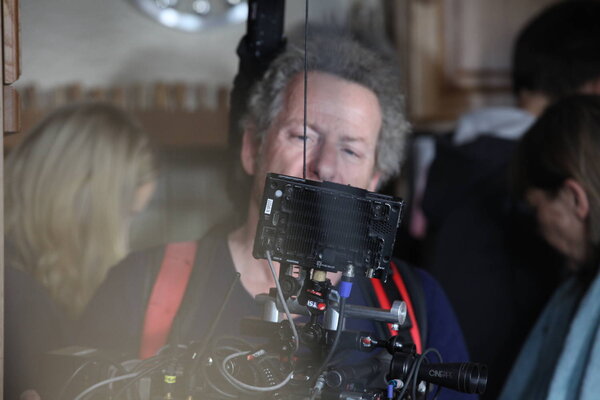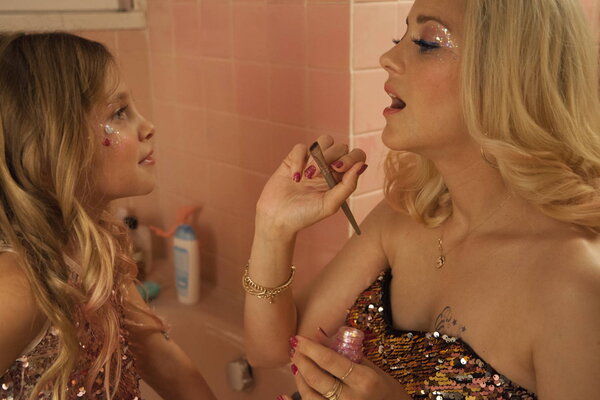“Lack of love” by François Reumont, on behalf of the AFC
Cinematographer Guillaume Schiffman, AFC, discusses his work on Vanessa Filho’s “Angel Face”
Guillaume Schiffman, AFC, and Vanessa Filho, were first connected via the producers of the latter’s first film. According to the cinematographer, “Christine de Jeckel asked me if I’d read the script and I found it pretty incredible. After searching Vanessa Filho’s name on the Internet, I realized that she was a photographer herself, as well as a musician, and that she’d shot music videos. An atypical personality that jibed with the writing, which was full of visual poetry, both fragile and deliberate. When I first met her, she mentioned Marion Cotillard, who was her first choice for the role of Eli’s mother. That’s also what convinced me, because my cinema is first and foremost about filming the actors.”
She’d already spent several months getting financing for the film, and so the young director had already assembled a lot of visuals on her mood board and had shot a short film with another child. “Vanessa’s world is very visual. She’d already had a lot of ideas and proposals regarding her film’s image. The little film she’d already shot, as a type of mock-up, was already very graphical in itself, and heavily referenced several contemporary photographers. Her involvement in editing, set design, and costume design, was major, and I am very proud to have been able to bring my own artistic touch to her universe, located between poetry and realism, in collaboration with the other members of the team.”
One of the main issues confronting this film was the almost permanent presence of a seven-year-old girl who plays the main character and through whose eyes the story is told.

“We did a lot of tests with Ayline, the young actress, and we very quickly realized that she wasn’t at all camera shy. Her ability to invent a character and play it was truly innate. Vanessa and I decided to keep the camera at her eyelevel most of the time, in order to strongly imprint her perspective on the image. The camera was set at a height of 1.30 metres most of the time, which meant that 90% of the time, the camera was carried on an Easy Rig outfitted with a Stab One. This unusual height caused a lot of low-angle shots on the adult actors, and a nearly permanent mobility to remain with her.”

[Guillaume Schiffman on the set of “Angel Face”]
When one first sees this film, one is taken aback by the many close-up shots, close to the faces, and the story that plunges the viewer directly into the characters’ point of view. “The opening sequence was very clearly a master shot for Vanessa, with an uninterrupted take on the main characters, from a high-angle, in which the viewer is supposed to understand through the sound and the image, that the relationship of responsibility between mother and child is basically being inverted.” The film was shot using Leica Summilux lenses, on an Arri Alexa Mini camera set at 1,600 ISO, “in order to counterbalance the rather vivid colours chosen as an artistic choice,” according to the cinematographer. “Besides, I love those Leica lenses, because they become softer in raw lighting. I used the 50mm lenses a lot, and developed the RAW in a 70s style, sometimes even adding 16mm graininess…”

In the screenplay, the story was already anchored in a Mediterranean setting. “In the beginning, Vanessa wanted her story to be set in Palavas-les-Flots. Thanks to the subsidies provided by the PACA Region, we ended up shooting in Saint-Cyr-sur-Mer, near Cassis. This is a small, working-class beach resort with a sort of dated appearance.” Nonetheless, everything wasn’t shot on location and the apartment, especially, was cut in half, with a set built in Aubervilliers (bedroom, bathroom, hallway, entrance) and a real apartment on location for the living room and the balcony. “That was a challenge. Especially since we began shooting in Paris, we had to anticipate in advance the level of sunlight we’d have in the South later on. I was careful to limit the depth of field, so it wouldn’t go too far past the windows, and I often created sun-drenched windows by putting lights outside of them. I built my image on the prop lighting provided by the set designers, and so I think I didn’t use more than three SL1 indoors on that set. Once we’d arrived in Saint-Cyr, the real apartment was south facing – which really didn’t make things easier for me – but the autumn sunlight (we shot between October and November) didn’t get inside any further than the balcony.”
Taking advantage of a bit of flexibility in the shooting schedule to shoot those indoor scenes alone with Ayline, the cinematographer says he often used natural lighting, often reflected off of surfaces placed outdoors. “I remember that Vanessa really wanted us to use that very white and very strong light that one finds on the Mediterranean coast,” says Guillaume Schiffman. “For example, on the parking lot set with the mobile homes, in the heart of the Calanques nature reserve, she didn’t hesitate to place Marion’s character facing the sun while she attempts to join her daughter. Just like there’s a shot in the prior scene where you see the tip of the cliff with the sun in the middle of the frame.”

Night is also an important narrative element in the film. Marlène’s (played by Marion Cotillard) outings to the nightclub and the street sequences provide rhythm to the story. Guillaume Schiffman admits that he was tempted to invent a night-time lighting different from what he usually does : “While searching for the right colour temperature setting on the camera, I got a golden effect on sodium lights. For the scene where they’re leaving the night club, I just lit three palm trees in the background, put up three home-made sodium lights, and a SkyPanel set to blue that played a magical counterpoint. Since we were filming at 1,600 ISO in very low lighting conditions on that set, I noticed that the car’s taillights really marked the actors’ faces. So we brought the car closer to the actors in the scenography so that we could use the natural red ambience on them…”

Asked about his membership in the AFC, Guillaume Schiffman said that because of how much he works, he isn’t able to regularly participate in the association. “My participation in the AFC essentially takes place via the films I shoot and that allow me to represent the association at festivals, master classes, and other cinema events. I’d like to be able to participate more actively, but, honestly, I just don’t have the time. In any event, I regularly phone members whose work I’ve recently noticed or admired to congratulate them and have a discussion with them. Personally, I’m not a cinematographer who keeps my techniques secret from others, so I like to share my methods during the monthly screenings and especially at the Micro Salon, which is a great opportunity to have conversations. I am perfectly aware of the important role our association has to play, and I would definitely be very sad not to be a member of it.”
(... by François Reumont, and translated from French by Alexander Baron-Raiffe)
A young woman lives alone with her eight-year-old daughter. One night, after meeting someone at a nightclub, she decides to leave, leaving her daughter to fend for herself alone…
Producers : Carole Lambert – Marc Missonier
Set designer : Nicolas Miguot
Sound Engineer : Xavier Dreyfuss
Editor : Sophie Reine
 En
En Fr
Fr




